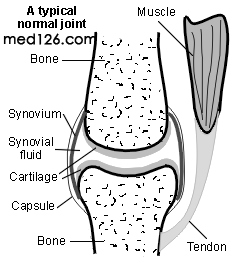
What is osteoarthritis?
Arthritis means inflammation of the joints. Osteoarthritis (OA) is the most common form of arthritis in the UK. OA mainly affects the joint cartilage and the bone tissue next to the cartilage.
Understanding joints
 A joint is where two bones meet. Joints allow movement and flexibility of various parts of the body. The movement of the bones is caused by muscles which pull on tendons that are attached to bone.
A joint is where two bones meet. Joints allow movement and flexibility of various parts of the body. The movement of the bones is caused by muscles which pull on tendons that are attached to bone.
Cartilage is a hard, smooth tissue that covers the end of bones. Between the cartilage of two bones which form a joint there is a small amount of thick fluid called synovial fluid. This fluid 'lubricates' the joint which allows smooth movement between the bones.
The synovial fluid is made by the synovium. This is the tissue that surrounds the joint. The outer part of the synovium is called the capsule. This is tough, gives the joint stability, and stops the bones from moving 'out of joint'. Surrounding ligaments and muscles also help to give support and stability to joints
What causes osteoarthritis?
In joints with OA, the cartilage becomes damaged and worn. OA is often called the 'wear and tear' arthritis. This is too simple, and the exact reason why the cartilage of some joints becomes damaged is not clear. Factors that may play a role include:
Who gets osteoarthritis?
Which joints are affected?
The hips, knees, finger joints, thumb joints, and lower spine are the common joints affected. Less commonly affected joints are shoulders, elbows, wrists, ankles, and toe joints. In many cases, just a few joints develop symptoms with one or two becoming the most troublesome. In some people, OA develops in many joints.
What are the symptoms of osteoarthritis?
What is the outlook (prognosis) for people with osteoarthritis?
To have a certain degree of OA can almost be considered a normal part of ageing. A common wrong belief is that OA is always a progressive and serious disease. The severity of symptoms varies. In many older people, OA is mild, does not become worse, and does not make you any more disabled than expected for your age.
Symptoms often wax and wane. Sometimes this is related to such things as the weather. Symptoms often improve in warmer months. A bad spell of symptoms may be followed by a relatively good period. However, in some cases, the severity of OA and the disability it causes is out of proportion to your age. One or more joints may become particularly badly affected.
General measures to help treat osteoarthritis
Exercise
If possible, exercise regularly. This helps to strengthen the muscles around affected joints, to keep you fit, and to maintain a good range joint movement. Swimming is ideal for most joints, but any exercise is better than none. Many people can manage a regular walk.
Weight control
If you are overweight, try to lose some weight as the extra burden placed on back, hips, and knees can make symptoms worse. Even a modest amount of weight loss can make quite a difference.
Shoe insoles and other devices
Some research trials have shown that the following may help to ease symptoms from OA of the knee in some cases.
These measures slightly alter the distribution of weight and pressure on the knee joint, which is why they are thought to ease symptoms in some cases. A podiatrist or physiotherapist can advise exactly how to use them.
Walking aids
If you have OA of a hip or knee, when walking try using a cane (walking stick). Hold it in the hand on the opposite side of the body to the affected joint. This takes some pressure off the affected joint and helps to ease symptoms in some cases.医学 全在.线提供
Physiotherapy
Sometimes advice or treatment from a physiotherapist is helpful. For example:
Occupational therapy
May help if you need aids or modifications to your home to cope with disability caused by OA.
Other therapies
Some people have found that TENS machines help to ease pain from OA. A TENS machine (Transcutaneous Electrical Nerve Stimulator) delivers small electrical pulses to the body via electrodes placed on the skin. Acupuncture may also help to ease symptoms in some cases.